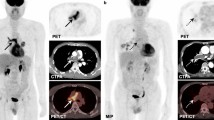Abstract
Objective
The purpose of this study was to evaluate the usefulness of 18F-fluorodeoxyglucose (FDG) positron emission tomography (PET) in differentiating pulmonary artery sarcoma from pulmonary embolism.
Materials and methods
We evaluated three patients with pulmonary artery sarcoma and 10 patients with proximal pulmonary embolism (6 men and 7 women, ranging in age from 35 to 94 years). All the patients had evidence of perfusion defects in their proximal pulmonary arteries on contrast-enhanced computed tomography (CT) scans performed prior to PET/CT. The maximum standardized uptake value (SUVmax) of FDG uptake in all the lesions was measured using PET/CT. The location of lesions, background uptake or thrombi in the legs were evaluated in both groups as basic characteristics.
Results
The mean SUVmax of the pulmonary artery sarcomas (7.63 ± 2.21, n = 3) and the pulmonary embolisms (2.31 ± 0.41, n = 10) were significantly different (P < 0.05). The mean times between the initial contrast-enhanced CT scan and PET/CT scan were similar in both groups (P = 0.7804). The differences in the locations in lesions between the three groups (right, left and bilateral) or background uptakes were not significant.
Conclusion
FDG PET/CT could distinguish pulmonary artery sarcoma from pulmonary embolism based on the SUVmax value.


Similar content being viewed by others
References
Tapson VF. Acute pulmonary embolism. N Engl J Med. 2008;358:1037–52.
Coli A, Parente P, Bigotti G. Pulmonary artery sarcoma: an insidious tumor still diagnosed too late: analysis of the literature and report of a case. J Exp Clin Cancer Res. 2007;26:151–6.
Levy E, Korach A, Amir G, Milgalter E. Undifferentiated sarcoma of the pulmonary artery mimicking pulmonary thromboembolic disease. Heart Lung Circ. 2006;15:62–3.
Sandhu A, Yates TJ, Kuriakose P. Pulmonary artery sarcoma mimicking a pulmonary embolism. Indian J Cancer. 2008;45:27–9.
Kaplinsky EJ, Favaloro RR, Pombo G, Perrone SV, Vigliano CA, Schnidt JL, et al. Primary pulmonary artery sarcoma resembling chronic thromboembolic pulmonary disease. Eur Respir J. 2000;16:1202–4.
Yi CA, Lee KS, Choe YH, Han D, Kwon OJ, Kim S. Computed tomography in pulmonary artery sarcoma. J Comput Assist Tomogr. 2004;28:34–9.
Cox JE, Chiles C, Aquino SL, Savage P, Oaks T. Pulmonary artery sarcomas: a review of clinical and radiologic features. J Comput Assist Tomogr. 1997;21:750–5.
Gotway MB, Patel RA, Webb WR. Helical CT for the evaluation of suspected acute pulmonary embolism: diagnostic pitfalls. J Comput Assist Tomogr. 2000;24:267–73.
Semin C, Tae SK, Byung TK, Eun YC, Jhingook K. Pulmonary artery sarcoma mimicking pulmonary thromboembolism: integrated FDG PET/CT. AJR. 2007;188:1691–3.
Ishiguro T, Kasahara K, Matsumoto I, Waseda R, Minato H, Kimura H, et al. Primary pulmonary artery sarcoma detected with a pulmonary infarction. Intern Med. 2007;46:601–4.
Allen S, Todd J, Copley S, Al-Nahhas A. F-18FDG uptake in bilateral pulmonary artery leiomyosarcomata, one mimicking a pulmonary embolus. Clin Nucl Med. 2005;30:418–9.
Kamel EM, McKee TA, Calcagni ML, Schmidt S, Markl S, Castaldo S, et al. Occult lung infarction may induce false interpretation of 18F-FDG PET in primary staging of pulmonary malignancies. Eur J Nucl Med Mol Imaging. 2005;32:641–6.
Kim HK, Choi YS, Kim K, Shim YM, Sung K, Lee YT, et al. Surgical treatment for pulmonary artery sarcoma. Eur J Cardiothorac Surg. 2008;33:712–6.
Conrad W, James AS. 18F-FDG of pulmonary embolism. AJR. 2007;189:171–6.
Ramos SG, Salvatti LG, Cipriano FG, Roriz-Filho JS, Matos FD, Rossi MA. Pulmonary artery sarcoma and chronic thromboembolism. Pathol Res Pract. 2008;204:139–41.
Tanaka I, Masuda R, Inoue M, Kasahara D, Furuhata Y, Shimizu S, et al. Primary pulmonary-artery sarcoma: report of a case with complete resection and graft replacement, and review of 47 surgically treated cases reported in the literature. Thorac Cardiovasc Surg. 1994;42:64–8.
Sone T, Yoshikawa K, Fukunaga M. Pulmonary tumor embolism from choriocarcinoma: detection with F-18 FDG positron emission tomography. Clin Nucl Med. 2008;33:773–4.
Acknowledgments
Part of this study was supported by Grants-in-aid for Cancer Research (No. 17-12) from the Ministry of Health, Labour and Welfare to Kazuo Kubota.
Author information
Authors and Affiliations
Corresponding author
Rights and permissions
About this article
Cite this article
Ito, K., Kubota, K., Morooka, M. et al. Diagnostic usefulness of 18F-FDG PET/CT in the differentiation of pulmonary artery sarcoma and pulmonary embolism. Ann Nucl Med 23, 671–676 (2009). https://doi.org/10.1007/s12149-009-0292-y
Received:
Accepted:
Published:
Issue Date:
DOI: https://doi.org/10.1007/s12149-009-0292-y




